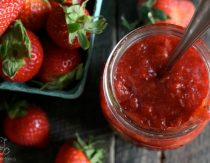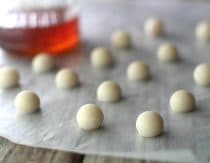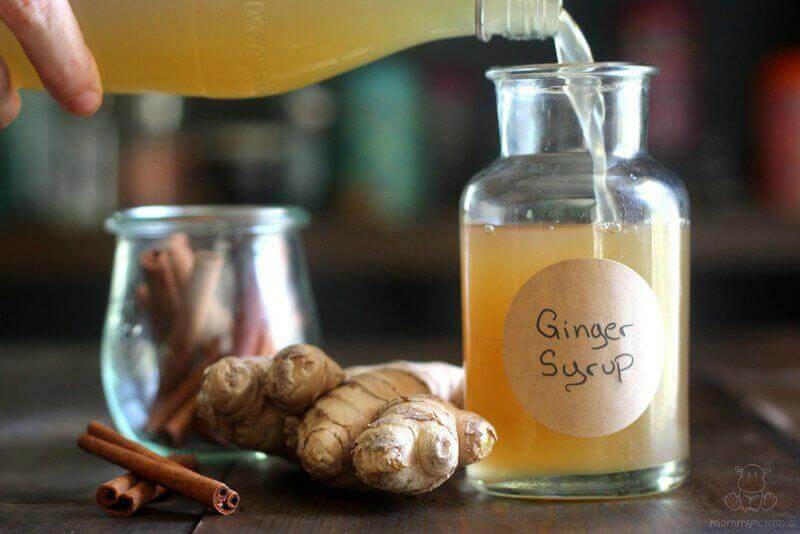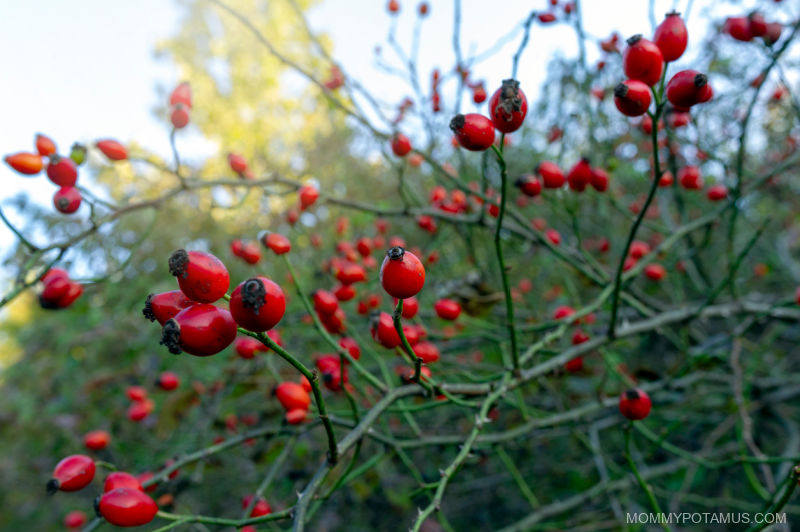
The benefits of rosehips are legendary . . . literally. According to Nordic folklore, Viking raids were fueled by the fruit of the rose plant – rosehips – which are loaded with vitamin C and other compounds that support immunity, vitality and well-being.
I’ve already shared my recipe for making a refreshing, slightly tart, lightly fruity tea, so in this article I’m going to share recipes for rosehip syrup, jam, tincture, oxymel and elixir.
If you’re not even sure what all those things are, don’t worry – you will by the end of this article. 🙂 But first, you might be wondering . . .
What are the benefits of rosehips?
Harvested between late summer and the first frost of each year, rosehips are rich in a variety of therapeutic compounds that:
- Support skin elasticity and collagen production
- Counteract oxidative stress
- Have a positive influence on cardiovascular biomarkers
- Support immune function
- Ease digestive issues
. . . and more. For a deeper dive into what current research says about the benefits of rosehips, check out this article.
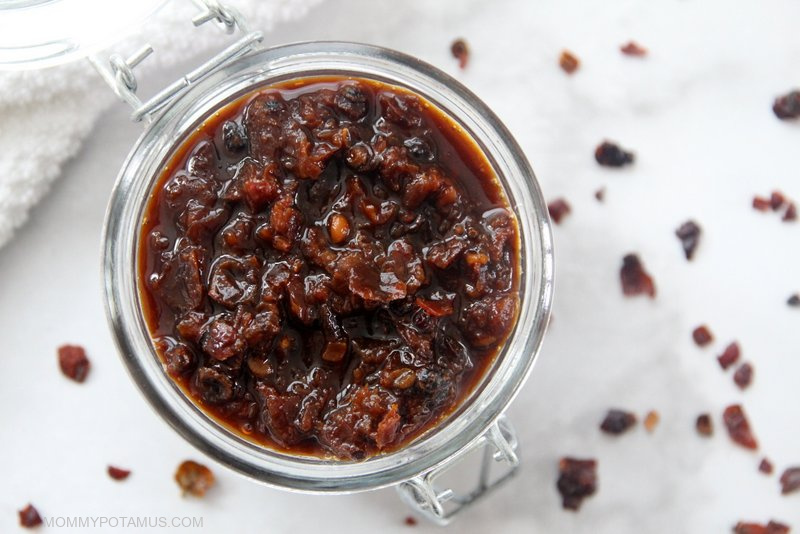
Rosehip Jam Recipe
Making jam with rosehips is super simple. Though they have very little natural pectin, rosehips thicken up nicely without it, and since this is a fridge jam you don’t need complicated equipment – no water bath, sterilized lids or canning jar tongs necessary.
It’s got a tart, slightly fruity flavor with hints of marmalade thanks to the addition of orange juice and zest.
One quick note: While rosehip tea, syrup, oxymel and elixir are pretty universally loved, opinions are more split on rosehip jam. My littlest will eat it by the spoonful if allowed, but my middle child is not a fan. Oh well, more for me!
Ingredients
- 1/2 cup dried rosehips (deseeded)
- 1 cup orange juice
- 1/4 cup honey
- 2 tsp lemon juice
- 1/2-1 tsp grated orange zest
- Combine rosehips, orange juice, lemon juice and grated orange peel in a small pot.
- Bring liquid to a simmer and cook for 5-7 minutes, mashing gently with a fork to break the rosehips into smaller pieces.
- When the mixture is finished simmering it should look a little like runny whole cranberry sauce (with small pieces of rosehips instead of whole cranberries).
- Allow the mixture to cool to room temperature, then stir in the honey and transfer to a clean jar with a lid. Store in the fridge and enjoy within two weeks.
- It can also be frozen for up to a few months.
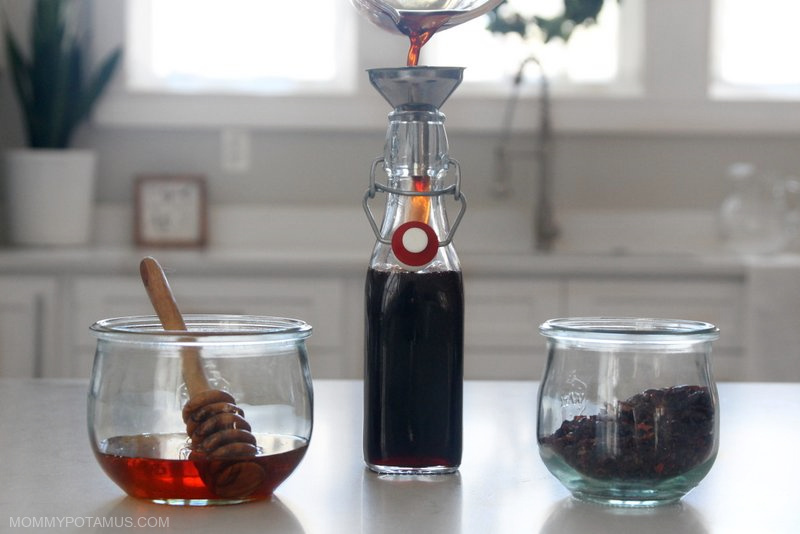
Rosehip Syrup Recipe
This recipe uses the same process that’s used for making elderberry syrup and other herbal syrups.
Ingredients
- ½ cup deseeded dried rosehips
- 2 cups water
- 1 cup raw honey *
- 1 tablespoon hibiscus flower (optional, adds flavor and a touch of color)
Instructions
- Add water and rosehips to a pot and bring to a boil.
- Reduce heat and simmer until the liquid is reduced by half. This should take around 45 minutes.
- Pour the liquid through a fine mesh strainer or cheesecloth to remove the berries. If using hibiscus flowers, add them in and allow them to infuse as the liquid cools. It may seem weird to strain the liquid and then add herbs back in, but there’s a reason. The berries will soak up extra liquid if they’re allowed to sit too long, but the flowers are best extracted in just-boiled water (aka an infusion) versus long-simmered water (aka a decoction).
- Allow liquid to cool to room temperature (or is at least less than 110F, then strain out the hibiscus flowers if needed.
- Measure the liquid to see how much you have. It should be about 1 cup, but it could be a little more or a little less. If you have 1 cup, measure out 1 cup honey and stir it in. If you have a little more liquid use enough honey to equal it, and if you have less liquid reduce the amount of honey you use.
- Transfer rosehip syrup to a sterilized mason jar (or other glass jar with a lid) and refrigerate.
According to The Modern Herbal Dispensatory, “Syrup made in this manner has an expected shelf-life of 1 year. Keep opened containers under refrigeration. The syrup must be discarded if mold appears on the surface.”
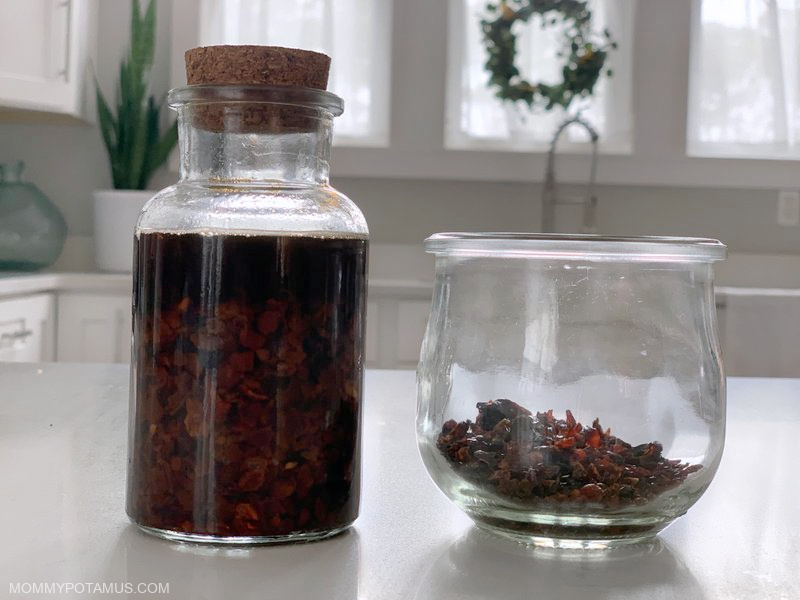
Rosehip Tincture Recipe
This small batch recipe is based on the formula found in DIY Bitters, which is sweet, sour and mildly floral.
It’s a 1:3 tincture, which just means that you use one part herb (by weight) to three parts alcohol (by volume).
Ingredients
- 1 ounce deseeded dried rosehips (by weight)
- 4 ounces 80 proof alcohol (by volume)
To Make
- Add 1 ounce of dried deseeded rosehips (by weight) to a 16 ounce jar. Pour the alcohol over the rosehips, then cover the with a lid and shake it well. If desired, write the start date on the jar using a sticky note, label, or piece of tape – it makes keeping track of how long it’s been steeping easier.
- Place the jar in a dark, room temperature area. (I keep mine in a kitchen cabinet.) Let the mixture steep for 3-5 more weeks. Shake occasionally.
- When it’s ready, strain the mixture through a cheesecloth or mesh strainer, making sure to squeeze out as much liquid as possible. Pour the tincture in a clean jar or dropper bottle and store it in a cool, dark area.
To Use
Store-bought preparations of the same strength generally recommend about 20-30 drops in water or juice up to four times daily. In general, it’s a good idea to take short breaks from most herbs at least every few months or so (depending on the herb).
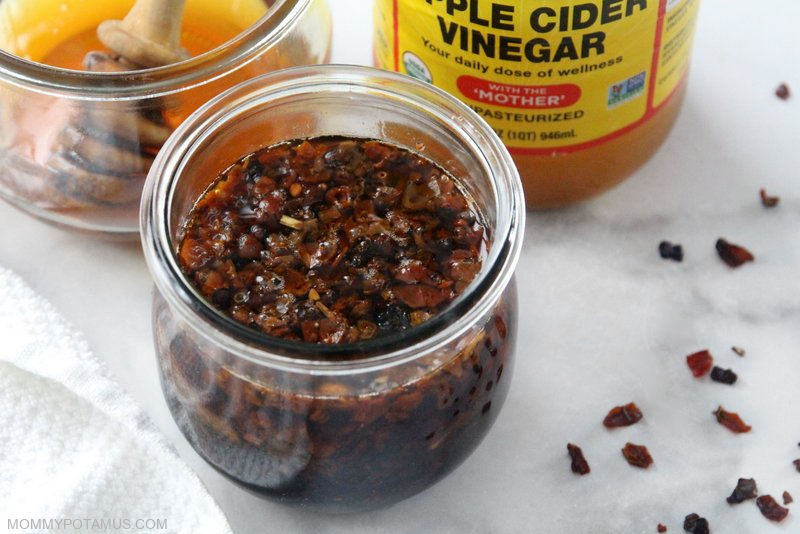
Rosehip Oxymel Recipe
As I explain in this article on different herbal preparations, “oxymel” is derived from the Latin word oxymeli, which means “acid and honey.” It’s usually made by infusing pungent herbs in vinegar and honey – a sweet, tangy, and yummy combination.
Because it’s made without heat, this oxymel brings together the digestion supporting goodness of raw apple cider vinegar with enzyme-rich raw honey while preserving a high percentage of the vitamin C naturally found in rosehips.
Ingredients
Although the ratios of honey and vinegar can vary, I make mine with . . . .
- 1 part raw apple cider vinegar
- 1 part honey (preferably raw)
- dried rosehips (deseeded)
To Make
- Fill a jar 1/4 full with dried rosehips, then fill the rest of the jar with equal parts honey and vinegar.
- Stir the mixture, then place a lid on the jar and give it a good shake.
- Place the jar in a cool, dark area and allow to infuse for two weeks.
- When it’s ready, strain out the herbs, pour the oxymel into a clean jar, label it, and store it in the fridge. Shake before using.
To Use
Like tinctures, oxymels are usually taken by the dropperful. They usually last six months or more.
How To Make Rosehip Elixir
An elixir is basically a sweetened tincture. To make one, you simply made a standard tincture, except you use a blend of honey and alcohol instead of just alcohol. Easy peasy.
Ingredients
- 1 ounce deseeded dried rosehips (by weight)
- 2 ounces 80 proof alcohol (by volume)
- 2 ounces organic raw honey
To Make
- Add 1 ounce of dried deseeded rosehips (by weight) to a 16 ounce jar.
- Pour the honey over the dried rosehips and stir to combine.
- Pour the alcohol over the rosehips and honey mixture, then stir again. If desired, write the start date on the jar using a sticky note, label, or piece of tape – it makes keeping track of how long it’s been steeping easier.
- Place the jar in a dark, room temperature area. (I keep mine in a kitchen cabinet.) Let the mixture steep for 3-5 more weeks. Shake occasionally.
- When it’s ready, strain the mixture through a cheesecloth or mesh strainer, making sure to squeeze out as much liquid as possible. Pour the tincture in a clean jar or dropper bottle and store it in a cool, dark area.
To Use
Like tinctures, elixirs are usually taken by the dropperful.
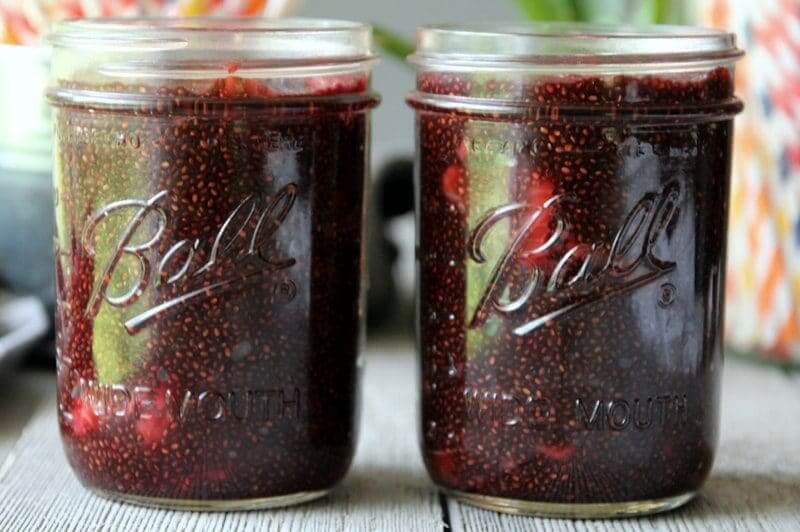
More Herbal Syrup & Jam Recipes To Try
Elderberry & Strawberry Jam – Making elderberry syrup soon? With a few quick additional steps, you can make a jar of syrup AND jam for just .000001% more effort.
Ginger Syrup Recipe – Ginger has been used for thousands of years to soothe tummy aches, nausea and indigestion, as well as support immune function. I like to keep this ginger syrup on hand during the cold winter months along with other syrups, tinctures and teas that support the immune system.
Schisandra Berry Syrup – Modern research has confirmed that schisandra berry is a highly valuable “adaptogen” (or herb that helps the body to adapt to emotional and physical stress). Here’s how to make this “five flavor fruit” into a yummy syrup.
Rosehip Jam Recipe
Ingredients
- ½ cup deseeded dried rosehips
- 1 cup freshly squeezed orange juice
- 2 tsp lemon juice
- ½ tsp grated orange zest
- ¼ cup honey (or more to taste)
Instructions
- Combine rosehips, orange juice, lemon juice and grated orange peel in a small pot.
- Bring liquid to a simmer and cook for 5-7 minutes, mashing gently with a fork to break the rosehips into smaller pieces.
- When the mixture is finished simmering it should look a little like runny whole cranberry sauce (with small pieces of rosehips instead of whole cranberries).
- Allow the mixture to cool to room temperature, then stir in the honey and transfer to a clean jar with a lid. Store in the fridge and enjoy within two weeks. It can also be frozen for up to a few months.
Notes
Nutrition
Want more research-backed natural remedies?
No problem, I’ve created a free ebook for you – Kitchen Apothecary: 25+ Natural Remedies Using Ingredients From Your Pantry – as a gift for signing up for my newsletter. You’ll also get updates when I post about safe essential oils for pregnant/breastfeeding mamas, exclusive gifts and coupons (I was able to give away a jar of free coconut oil to anyone who wanted it recently!), plus other goodies.
Sign up using the form below.


 Tried this recipe?
Tried this recipe? 